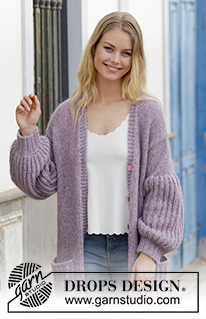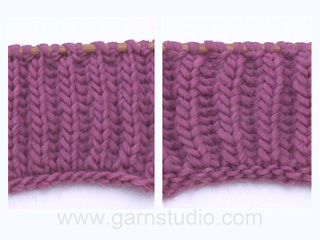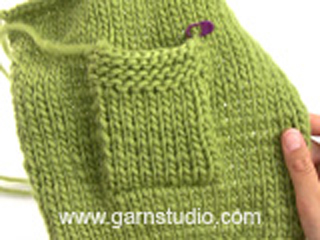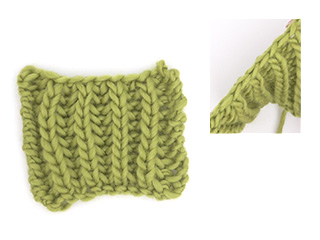Wayfarer |
|
 |
 |
Knitted jacket with English rib, stockinette stitch and pockets. Sizes S - XXXL. The piece is worked in DROPS Air.
DROPS 191-18 |
|
|
INFORMATION FOR THE PATTERN: RIDGE/GARTER STITCH (worked back and forth): 1 ridge = Knit 2 rows. ENGLISH RIB (back and forth on needle, including 1 edge stitch in each side): ROW 1: 1 stitch garter stitch, * knit 1, 1 yarn over, slip 1 stitch as if to purl *, work from *-* until there are 2 stitches left, finish with knit 1, 1 stitch garter stitch. ROW 2: 1 stitch garter stitch, * 1 yarn over, slip 1 stitch as if to purl, knit the yarn over and the slipped stitch together *, work from *-* until there are 2 stitches left, finish with 1 yarn over, slip 1 stitch as if to purl, 1 stitch garter stitch. ROW 3: 1 stitch garter stitch, * knit the yarn over and the slipped stitch together, 1 yarn over, slip 1 stitch as if to purl *, work from *-* until there are 3 stitches left, knit the yarn over and slipped stitch together, 1 stitch garter stitch. Repeat rows 2 and 3 upwards. DECREASE TIP -1 (= for the sides): All decreases are made from the right side! At the beginning of the row: Decrease 1 stitch after 2 stitches as follows: Slip 1 stitch as if to knit, knit 1, pass the slipped stitch over (= 1 stitch decreased). At the end of the row: Decrease 1 stitch before 2 stitches as follows: Knit 2 together (= 1 stitch decreased). DECREASE TIP -2 (for neck): All decreases are made from the right side! Decrease 1 stitch after the 5 band stitches as follows (applies to right front piece): Work 5 band stitches in garter stitch, slip 1 stitch as if to knit, knit 1, pass the slipped stitch over (= 1 stitch decreased). Decrease 1 stitch before the 5 band stitches as follows (applies to left front piece): Work until there are 7 stitches left, knit 2 together (= 1 stitch decreased), work 5 band stitches in garter stitch. BUTTONHOLES: Work buttonholes on the right band. 1 BUTTONHOLE = knit together the 3rd and 4th stitch from the edge and make 1 yarn over. On the next row knit the yarn over = hole. Work buttonholes when the piece measures: S: 14, 22, 31, 40, 49 and 58 cm M: 14, 23, 32, 41, 50 and 60 cm L: 14, 23, 32, 42, 52 and 62 cm XL: 14, 24, 34, 44, 54 and 64 cm XXL: 14, 24, 34, 44, 54 and 65 cm XXXL: 14, 24, 34, 45, 56 and 67 cm INCREASE TIP: (for sleeves) Increase by making 1 yarn over between 2 stitches; on the next row from the wrong side purl the yarn over twisted to avoid a hole. ---------------------------------------------------------- JACKET: The jacket is worked back and forth with circular needle, bottom up. The back piece and front pieces are worked separately and sewn together to finish. Then the sleeves are worked and sewn to the body. BACK PIECE: The piece is worked back and forth with circular needle. Cast on 81-84-90-99-105-114 stitches with circular needle size 7 mm / US 10.75 and Air. Work 4 stitches garter stitch, * knit 1, purl 2 *, work from *-* until there are 5 stitches left, finish with knit 1 and 4 stitches garter stitch. Work 6 rows like this. Then continue in stockinette stitch with 4 stitches garter stitch in each side, AT THE SAME TIME on the first row of stockinette stitch adjust the number of stitches to 80-84-90-98-106-114 stitches. REMEMBER THE GAUGE! When the piece measures 14 cm / 5½" cast on 1 edge stitch at the end of the next 2 rows (= 1 new stitch in each side of the piece) = 82-86-92-100-108-116 stitches. Then continue working stockinette stitch with 1 edge stitch in garter stitch in each side of the piece. When the piece measures 15 cm / 6" decrease 1 stitch inside the 2 stitches in each side of the piece – read DECREASE TIP-1 = 2 stitches decreased. Decrease like this every 8-8-8½-9-9½-10 cm / 4" a total of 6 times = 70-74-80-88-96-104 stitches. When the piece measures 58-60-62-64-66-68 cm / 22¾"-23⅝"-24⅜"-25¼"-26"-26¾" bind off 3-4-4-5-5-6 stitches for the armholes at the start of the next 2 rows = 64-66-72-78-86-92 stitches. Then bind off 1 stitch in each side every 2nd row a total of 0-0-1-3-5-7 times = 64-66-70-72-76-78 stitches. When the piece measures 75-78-81-84-87-90 cm / 29 ½"-30⅝"-31⅞"-33"-34 ¼"-35⅜" bind off the middle 16-18-20-20-22-22 stitches for neck = 24-24-25-26-27-28 stitches left on each shoulder. Then bind off stitches for diagonal shoulders at the beginning of each row towards the neck - i.e. at the beginning of each row from the right side on the right shoulder (when the garment is worn) and the beginning of each row from the wrong side on the left shoulder (when the garment is worn). Bind off for diagonal shoulders as follows: 6 stitches 3 times, then bind off the remaining 6-6-7-8-9-10 stitches. Repeat on the other side. The piece measures a total of 79-82-85-88-91-94 cm / 31"-32¼"-33½"-34⅝"-35¾"-37". RIGHT FRONT PIECE: Cast on 46-49-49-55-58-61 stitches (including 5 band stitches) with circular needle size 7 mm / US 10.75 and Air. Work as follows from the right side: 5 band stitches in garter stitch, * knit 1, purl 2 *, work from *-* until there are 5 stitches left, finish with knit 1 and 4 stitches in garter stitch. Work 6 rows like this. Then continue working from the right side as follows: 5 band stitches in garter stitch, work stockinette stitch until there are 4 stitches left, finish with 4 stitches in garter stitch, AT THE SAME TIME on the first row of stockinette stitch adjust the number of stitches to 45-47-50-54-58-62 stitches. When the piece measures 14 cm / 5½", adjust to match the back piece, cast on 1 edge stitch at the end of the next row from the right side = 46-48-51-55-59-63 stitches. Then continue with stockinette stitch and 5 band stitches in garter stitch towards mid front as before and 1 edge stitch in garter stitch towards the side. Work BUTTONHOLES on the band – see description above. When the piece measures 15 cm / 6", decrease 1 stitch inside the 2 stitches in the side at the end of the next row from the right side. Decrease like this every 8-8-8½-9-9½-10 cm / 4" a total of 6 times = 40-42-45-49-53-57 stitches. When the piece measures 58-60-62-64-66-68 cm / 22¾"-23⅝"-24⅜"-25¼"-26"-26¾" bind off for the armhole in the side as for the back piece = 37-38-40-41-43-44 stitches. AT THE SAME TIME when the piece measures 59-61-63-65-66-68 cm / 23⅛"-24"-24 ¾"-25 ½"-26"-26 ¾" decrease for the neck inside the 5 band stitches – read DECREASE TIP-2. Decrease like this every 4th row a total of 8-9-10-10-11-11 times = 29-29-30-31-32-33 stitches left when the neck decreases are finished. When the piece measures 75-78-81-84-87-90 cm / 29 ½"-30⅝"-31⅞"-33"-34 ¼"-35⅜" bind off for diagonal shoulder at the beginning of each row from the wrong side as follows: 6 stitches 3 times, 6-6-7-8-9-10 stitches 1 time = 5 band stitches left on the needle. Work garter stitch over the band stitches until the band measures approx. 10-11-11-12-13-13 cm / 3⅞"-4 ¼"-4 ¼"-4⅝"-5⅛"-5⅛" from the last bind off stitch on the shoulder (this will be sewn to the neck on the back piece). LEFT FRONT PIECE: Work as for the right front piece but reversed. Do not work buttonholes. SLEEVES: The sleeves are worked back and forth with circular needle. Cast on 44-47-47-50-50-53 stitches (including 1 edge stitch in each side of the piece) with circular needle size 4 mm / US 6 and Air. Work rib (= knit 1, purl 2) with 1 edge stitch in garter stitch in each side of the piece. When the rib measures 7-7-7-7-7-7 cm / 2 ¾"-2 ¾"-2 ¾"-2 ¾"-2 ¾"-2 ¾", adjust so that the next row is worked from the right side, work 1 row of rib as before AT THE SAME TIME as you increase 11-12-12-13-13-14 stitches evenly on row – read INCREASE TIP! = 55-59-59-63-63-67 stitches. Purl 1 row. Change to circular needle size 7 mm / US 10.75 and work ENGLISH RIB – see description above. Continue until the piece measures 37-37-37-37-37-37 cm / 14 ½"-14 ½"-14 ½"-14 ½"-14 ½"-14 ½" and then continue with stockinette stitch with 1 edge stitch in garter stitch in each side of the piece AT THE SAME TIME as you decrease 8-9-6-7-4-6 stitches evenly on the first row = 47-50-53-56-59-61 stitches. Continue with stockinette stitch until the piece measures 45-45-45-45-45-45 cm / 17⅝"-17⅝"-17⅝"-17⅝"-17⅝"-17⅝". Now bind off 4 stitches in each side, bind off in each side every 2nd row a total of 4 times = 15-18-21-24-27-29 stitches. Bind off the remaining stitches, the sleeve measures 50-50-50-50-50-50 cm / 19⅝"-19⅝"-19⅝"-19⅝"-19⅝"-19⅝". Work the other sleeve in the same way. POCKETS: Cast on 25 stitches with circular needle size 7 mm / US 10.75 and Air. Work 2 ridges then work ENGLISH RIB with 1 stitch in garter stitch in each side. When the piece measures 16 cm work 1 ridge, then bind off. Work one more pocket in the same way. ASSEMBLY: Sew the side seams inside the 1 edge stitch in garter stitch, sew down to the split (= 14 cm / 5½" split). Sew shoulder seams and sew the neck from the front pieces together and sew it to the neck on the back piece. Sew the sleeve seams inside the 1 edge stitch in each side, then sew the sleeves to the body. Sew buttons onto the left band. Sew a pocket onto each front piece – approx. 14 cm / 5½" from the bottom edge and 8 cm / 3⅛" from mid front – see photo. |
|

|
|
|
Have you made this or any other of our designs? Tag your pictures in social media with #dropsdesign so we can see them! Do you need help with this pattern?You'll find tutorial videos, a Comments/Questions area and more by visiting the pattern on garnstudio.com. © 1982-2024 DROPS Design A/S. We reserve all rights. This document, including all its sub-sections, has copyrights. Read more about what you can do with our patterns at the bottom of each pattern on our site. |
|
































































Comments / Questions (55)
Geachte heer/ mevrouw, Ik wil dit patroon plus garen graag bestellen, maar ik zie geen winkelwagentje, Kunt u mij helpen. Met vr groet,
31.03.2021 - 23:55DROPS Design answered:
Dag Heleen,
Het patroon kun je op onze site gratis downloaden via de knop 'Afdrukken' onderaan de materialenlijst. Voor het garen kun je terecht bij een van onze verkooppunten
01.04.2021 - 20:06À chaue fois que je tricot une bordure elle condolle toujours pourquoi..
04.03.2021 - 23:12DROPS Design answered:
Bonjour Mme Pellerin, je ne suis pas sûre de voir de quelle bordure vous parlez, toutefois, bien souvent un simple "blocage" peut permettre de retirer toute irrégularité, humidifiez votre ouvrage terminé (ou bien lavez-le en suivant les indications de l'étiquette) et faites le sécher bien à plat, en épinglant les parties "rebelles" si besoin. Bon tricot!
05.03.2021 - 07:44Jeg er i tvivl om, hvad der er ærmets længde og hvad der hører til ærmegabet - altså hvor langt skal ærmet syes sammen inden det monteres i ærmegabet?
03.02.2021 - 19:30DROPS Design answered:
Hej Mette, ærmet måler 45 cm når du tager ind til ærmekuppel :)
17.05.2021 - 16:01Szkoda, że zapytania i komentarze nie są tłumaczone na język polski, na pewno zawarte są w nich cenne uwagi :) taka moja sugestia i prośba , pozdrawiam ciepło Małgorzata
26.01.2021 - 14:29DROPS Design answered:
Witaj Małgorzato, obawiam się, że to byłoby bardzo trudne do wykonania. Zachęcam do zadawania pytań jak tylko pojawi się wątpliwość dotycząca wzoru, zawsze odpowiadamy:) Pozdrawiamy!
26.01.2021 - 16:05Hej. Jeg skal lukke af til skuldre, først ve side fra vrang siden, jeg forstår ikke hvad der menes, 6 masker 3 gange derefter lukkes de sidste 6 masker af? Hvordan skal det forstås? Mange hilsner Malene
04.01.2021 - 22:01DROPS Design answered:
Hei Malene. Du har 24 masker igjen på hver skulder.Fell 6 masker på første pinne fra vrangen, strikk pinnen ut, neste pinne fra vrangen felles det også 6 masker og 3. pinne fra vrangen felles det også 6 masker. Du har nå felt 18 masker og har 6 masker igjen på pinnen, fell nå de resterende 6 maskene av. Gjenta i den andre siden. God Fornøyelse!
13.01.2021 - 15:51Hallo! Habe die Jacke gerade fertig gestellt. Sie sieht toll aus in Jeansblau! Danke für die super Anleitung!
01.01.2021 - 13:56Hallo, beim Ärmel wird erst das Bündchen gestrickt, in der letzten Reihe nehme ich 11 Maschen zu, dann stricke ich Vollpatent bis ich 37 cm erreicht habe. Aber wann nehme ich die 8 Maschen ab? In der Beschreibung steht gleichzeitig mit Beginn des Wechsels auf Nadel 7.... Über eine kurze Rückmeldung würde ich mich freuen. Viele Grüße Peggy
05.10.2020 - 21:31DROPS Design answered:
Liebe Peggy, wenn die Ärmel 37 cm mist, dann stricken Sie 1 Reihe glatt rechts und gleichzeitig nehmen Sie 8 Maschen ab. Jetzt stricken Sie glatt rechts über die 47 Maschen bis die Arbeit 45 cm mist (immer noch mit der Nadel Nr 7). Viel Spaß beim stricken!
06.10.2020 - 10:52Drops pattern 191-18 Hi il doing this pattern but a bit confused on the shoulders on the back piece I cast off from the arms (not the neck) On the front sides do I cast off the same way or the other side eg after the band side?
11.07.2020 - 19:21DROPS Design answered:
Dear Aj, you cast off for shoulder at the beg of the row from the armhole (from RS on right shoulder, from WS on left shoulder). On right front piece, you cast off for shoulder at the beg of rows from WS and for left front piece at the beg of rows from RS. Happy knitting!
13.07.2020 - 09:35Bij dit patroon bij de uitleg van de Engelse Patentsteek staat bij naald 2: tot er 2 steken over zijn, eindig met 1 omslag, 1 steek averecht, 1 steek ribbelsteek. Dit moet volgens mij zijn: 1 omslag, 1 steek averecht afhalen, 1 steek ribbelsteek.
08.07.2020 - 10:53Jeg har et spørgsmål til højre forstykke - er det virkelig rigtigt, at jeg allerede skal begynde at tage ind , når arbejdet målet 15 cm? Og også allerede tage ind til knaphul der?
09.05.2020 - 19:11DROPS Design answered:
Hej Mette, Ja vi tager ind i hver side, så jakken former sig mere til kroppen. Og ja vi har lavet 6 knapper inden vi starter på indtagningerne til v-hals. Vil du kun have 5 knapper, så starter du bare højere oppe :)
12.05.2020 - 15:09